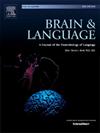小脑tDCS调节双语失语症的语言和执行功能:一个案例系列
IF 2.3
2区 心理学
Q1 AUDIOLOGY & SPEECH-LANGUAGE PATHOLOGY
引用次数: 0
摘要
本病例系列探讨小脑经颅直流电刺激(tDCS)对双语失语症患者语言和执行功能的影响。我们报告了7名被诊断为原发性进行性失语症(PPA)或卒中后失语症的荷兰-法国双语参与者,包括1名非流利型PPA (nfvPPA), 3名词性缺失型PPA (lvPPA), 1名语义型PPA (svPPA)和2名卒中后非流利型失语症患者。对右小脑后外侧进行20分钟的2 mA淋巴结tDCS,并辅以言语治疗。我们进行了双语失语症测试、波士顿命名测试、Stroop测试和注意网络测试的子测试。与假手术相比,小脑tDCS在两种语言的语言恢复和抑制控制方面都有更大的增强,这为小脑在语言和执行过程中的作用提供了证据。我们的研究结果有助于更深入地了解小脑刺激作为双语失语症的治疗工具,对未来的研究和临床干预具有重要意义。本文章由计算机程序翻译,如有差异,请以英文原文为准。
Modulating language and executive functions in bilingual aphasia with cerebellar tDCS: a case series
This case series explores the effects of cerebellar transcranial direct current stimulation (tDCS) on language and executive functions in bilinguals with aphasia. We present seven Dutch-French bilingual participants diagnosed with Primary Progressive Aphasia (PPA) or post-stroke aphasia, including one non-fluent variant PPA (nfvPPA), three logopenic variant PPA (lvPPA), one semantic variant PPA (svPPA), and two post-stroke non-fluent aphasia patients. 20 min of 2 mA anodal tDCS to the right posterolateral cerebellum was combined with speech and language therapy. We administered subtests of the Bilingual Aphasia Test, Boston Naming Test, Stroop, and Attention Network Tests. Cerebellar tDCS compared to sham led to greater enhancement of language recovery in both languages, and inhibitory control, providing evidence for the cerebellum’s role in both language and executive processes. Our findings contribute to a deeper understanding of cerebellar stimulation as a therapeutic tool in bilingual aphasia, with implications for future research and clinical interventions.
求助全文
通过发布文献求助,成功后即可免费获取论文全文。
去求助
来源期刊

Brain and Language
医学-神经科学
CiteScore
4.50
自引率
8.00%
发文量
82
审稿时长
20.5 weeks
期刊介绍:
An interdisciplinary journal, Brain and Language publishes articles that elucidate the complex relationships among language, brain, and behavior. The journal covers the large variety of modern techniques in cognitive neuroscience, including functional and structural brain imaging, electrophysiology, cellular and molecular neurobiology, genetics, lesion-based approaches, and computational modeling. All articles must relate to human language and be relevant to the understanding of its neurobiological and neurocognitive bases. Published articles in the journal are expected to have significant theoretical novelty and/or practical implications, and use perspectives and methods from psychology, linguistics, and neuroscience along with brain data and brain measures.
 求助内容:
求助内容: 应助结果提醒方式:
应助结果提醒方式:


